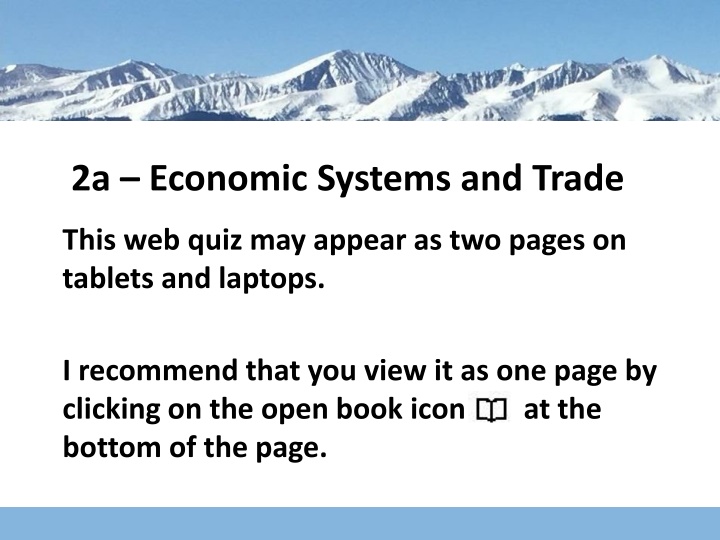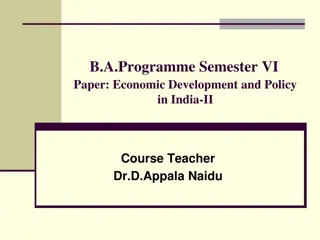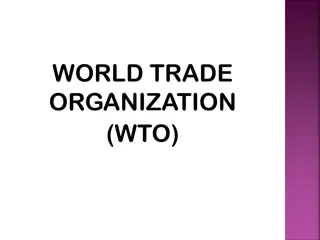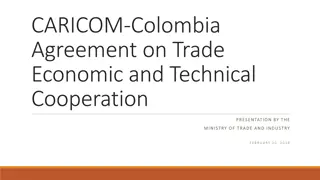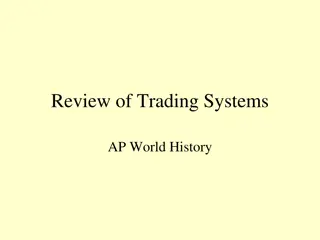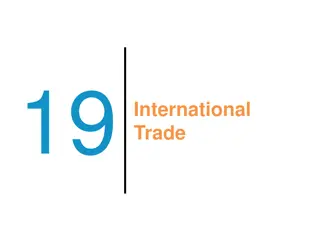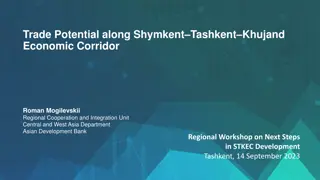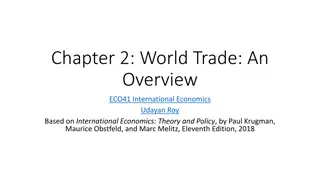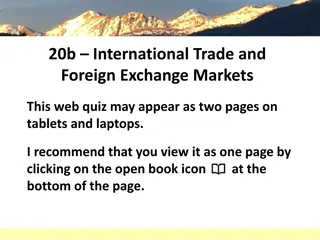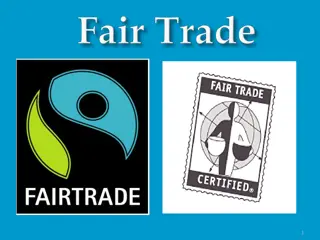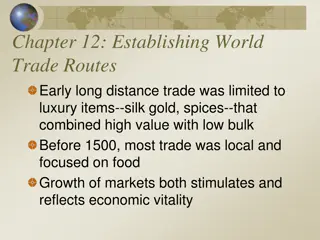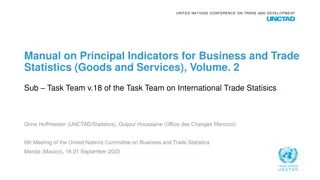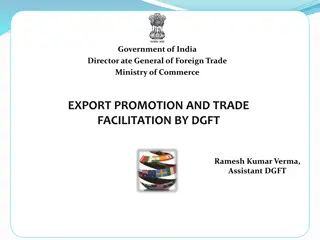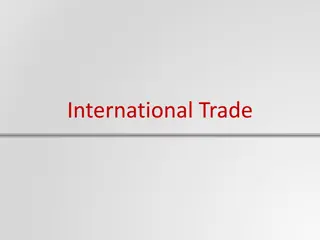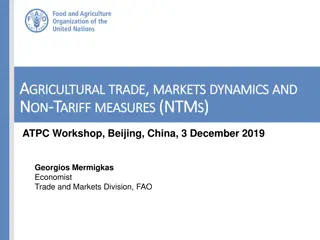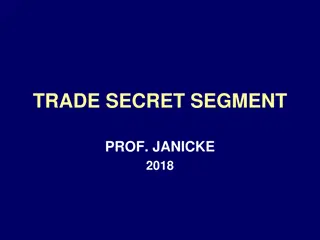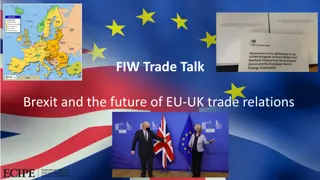Economic Systems and Trade Overview
This content covers economic systems such as market, command, and mixed economies, the benefits of trade, key terms, and quiz questions related to economic concepts. Explore the distinctions between economic systems and their impacts on trade and society.
Download Presentation

Please find below an Image/Link to download the presentation.
The content on the website is provided AS IS for your information and personal use only. It may not be sold, licensed, or shared on other websites without obtaining consent from the author.If you encounter any issues during the download, it is possible that the publisher has removed the file from their server.
You are allowed to download the files provided on this website for personal or commercial use, subject to the condition that they are used lawfully. All files are the property of their respective owners.
The content on the website is provided AS IS for your information and personal use only. It may not be sold, licensed, or shared on other websites without obtaining consent from the author.
E N D
Presentation Transcript
2a Economic Systems and Trade This web quiz may appear as two pages on tablets and laptops. I recommend that you view it as one page by clicking on the open book icon at the bottom of the page.
2a Economic Systems and Trade Economic Systems: Market Economies Command Economies Mixed Economies The Economic Benefits of Trade
2a Economic Systems and Trade Must Know / Outcomes: Trade: Economic Systems pure Laissez-faire economic system Centrally Planned Economy mixed economic systems the Bolshevik Revolution factors contributing to the collapse of the Soviet Union characteristics of the market system the important role of profits and losses property rights how specialization increases output the "invisible hand" of capitalism the coordination problem the incentive problem the circular flow model absolute advantage straight line PPCs comparative advantage calculate comparative advantage specialization and trade show the gains from trade
2a Economic Systems and Trade Key Terms Economic Systems economic system, command system (centrally planned, socialism), market system (capitalism, laissez-faire), mixed economic system, Bolshevik revolution, self interest, private property, freedom of enterprise and choice, competition, market, specialization, consumer sovereignty, dollar votes, invisible hand, creative destruction, coordination problem, incentive problem, circular flow diagram, product market, resource market, opportunity cost, The Gains from Trade absolute advantage, comparative advantage, gains from trade, free trade.
1. Which of the following is a distinguishing feature of the command system? 1. Private ownership of capital 2. Central planning 3. Heavy reliance on markets 4. Widespread dispersion of economic power
1. Which of the following is a distinguishing feature of the command system? 1. Private ownership of capital 2. Central planning 3. Heavy reliance on markets 4. Widespread dispersion of economic power
2. The French term laissez-faire means: 1. there is no free lunch 2. let it be 3. circular flow 4. public ownership
2. The French term laissez-faire means: 1. there is no free lunch 2. let it be 3. circular flow 4. public ownership
3. Specialization in production is economically beneficial primarily because it: 1. Allows everyone to have a job they like 2. Facilitates trade by bartering 3. Guarantees full employment 4. Permits more output from the same resources
3. Specialization in production is economically beneficial primarily because it: 1. Allows everyone to have a job they like 2. Facilitates trade by bartering 3. Guarantees full employment 4. Permits more output from the same resources
4. Economic profits in an industry suggest the industry: 1. Can earn more profits by increasing the price 2. Should be larger to satisfy consumers 3. Has excess capacity 4. Is the correct size for consumers
4. Economic profits in an industry suggest the industry: 1. Can earn more profits by increasing the price 2. Should be larger to satisfy consumers 3. Has excess capacity 4. Is the correct size for consumers
5. The invisible hand promotes society s interest because: 1. Individuals pursuing their self-interest will produce goods that people want 2. Individuals will produce goods for others out of concern for their fellow human beings 3. It makes sure that everybody wins from competition 4. Government regulation pushes businesses into producing the right mix of goods
5. The invisible hand promotes society s interest because: 1. Individuals pursuing their self-interest will produce goods that people want 2. Individuals will produce goods for others out of concern for their fellow human beings 3. It makes sure that everybody wins from competition 4. Government regulation pushes businesses into producing the right mix of goods
6. The coordination problem in centrally planned economies refers to the idea that: 1. Planners had to direct required inputs to each enterprise 2. The price level and the level of employment are inversely related 3. The immediate effect of more investment was less consumption 4. exports had to equal imports for a central plan to work
6. The coordination problem in centrally planned economies refers to the idea that: 1. Planners had to direct required inputs to each enterprise 2. The price level and the level of employment are inversely related 3. The immediate effect of more investment was less consumption 4. exports had to equal imports for a central plan to work
7. Flow 3 represents: 1. Wages, rents, interest, profits 2. Land, labor, capital, entrepreneurs 3. Goods and services 4. Consumer expenditures
7. Flow 3 represents: 1. Wages, rents, interest, profits 2. Land, labor, capital, entrepreneurs 3. Goods and services 4. Consumer expenditures
8. In Pakistan, the op. cost of 1 Wheat is: 1. 0 Rice 2. rice 3. 2/3 Rice 4. 20 Rice3
8. In Pakistan, the op. cost of 1 Wheat is: 1. 0 Rice 2. rice 3. 2/3 Rice 4. 20 Rice3
9. Who should export what? 1. Pakistan both wheat and rice 2. Pakistan wheat, Malaysia rice 3. Pakistan rice, Malaysia wheat 4. Malaysia both wheat and rice
9. Who should export what? 1. Pakistan both wheat and rice 2. Pakistan wheat, Malaysia rice 3. Pakistan rice, Malaysia wheat 4. Malaysia both wheat and rice 0% 0% 0% 0% Pakistan both wheat and... Malaysia both wheat and... Pakistan wheat, Malaysia... Pakistan rice, Malaysia ...
10. Assume before specialization, Pakistan is at C and Malaysia at B , If they specialize 100%, then the gains will be: 1. 45 wheat and 20 rice 2. 20 rice 3. 5 wheat 4. 15 wheat
10. Assume before specialization, Pakistan is at C and Malaysia at B , If they specialize 100%, then the gains will be: 1. 45 wheat and 20 rice 2. 20 rice 3. 5 wheat 4. 15 wheat
